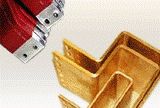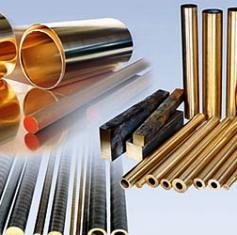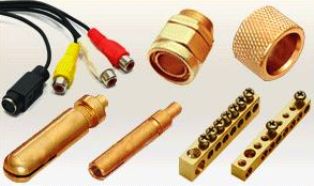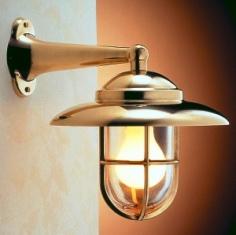Bronzes and brasses in electrical engineering
 Of the copper-based alloys, bronze and brass are the most widely used in electrical engineering.
Of the copper-based alloys, bronze and brass are the most widely used in electrical engineering.
Bronze — a copper-based alloy in which the main additives are tin, aluminum, beryllium, silicon, lead, chromium or other elements, except for zinc and nickel. Bronze is called tin, aluminum, beryllium, etc. respectively. An alloy of copper with zinc is called brass, and with nickel it is called a copper-nickel alloy. A variety of bronze with high strength, plasticity, corrosion resistance, antifriction properties, etc. valuable qualities used in various branches of technology and for casting artistic products.
So bronze — these are alloys honey with tin, aluminum and other metals specially introduced in order to obtain certain properties of the alloy. Tin bronzes, in which the content of tin is 8 - 20%, began to be used earlier than all.
Tin bronzes are expensive alloys because they contain scarce tin. Therefore, they try to replace tinned bronzes with other bronzes containing aluminum, cadmium, phosphorus and other substances (alloying elements).
A characteristic feature of bronzes is their low volume shrinkage during casting (0.6 — 0.8%) compared to cast iron and steels, where the shrinkage reaches 1.5 — 2.5%. Therefore, the most complex parts are cast from bronze. Other characteristic properties of bronzes — increased hardness, elasticity (compared to copper), high abrasion resistance and corrosion resistance. Because of these valuable properties, bronze is widely used in mechanical engineering to produce bushings, gears, springs (bronze strip) and other parts.
Rice. 1. Bronzes in electrical engineering
Bronze grades are indicated by the letters Br (bronze), followed by letters and numbers indicating which alloying elements and in what quantity are contained in a given bronze. For example, the brand BrOTsS-5-5-5 means that the bronze contains 5% tin, 5% zinc, 5% lead, the rest is copper.
Bronzes are foundry, from which parts are obtained by casting, and bronzes are pressure-worked. The density of bronzes is in the range: 8.2 — 8.9 g / cm3. In electrical engineering, they try to use bronzes whose conductivity is close to that of copper. Such bronzes are cadmium and cadmium-tin. The remaining bronzes are used in electrical engineering due to the following properties: elasticity, wear resistance and high mechanical strength.
Bronze is used for the production of wires with increased mechanical strength, as well as for brush holders, springs and contact parts for electrical devices and devices.
Aluminum bronzes have the highest plasticity. Beryllium bronzes are characterized by very high mechanical strength, resistance to abrasion and oxidation in air.
In addition to bronzes, copper-zinc alloys are widely used in electrical engineering — brass, where the zinc content can be up to 43%. With this zinc content, brass has the highest mechanical strength. Cuts containing 30 — 32% zinc have the highest plasticity, which is why products are produced from them by hot or cold rolling and drawing: sheets, strips, wire, etc.
Rice. 2. Brass in electrical engineering
Without heating, complex parts can be made from sheet brass by deep drawing and stamping: casings, caps, shaped washers, etc. As a result of cold working with pressure, the hardness and mechanical strength of brass increases, but the ductility is significantly reduced. To restore plasticity, the brass is annealed at a temperature of 500 — 600 ° C and slowly cooled to room temperature.
Brass can be cut well. Brass products are resistant to atmospheric corrosion, but deformed (drawn) brass is more susceptible to corrosion in humid atmospheres than copper.
In order to increase the corrosion resistance of brasses, alloying elements are introduced into them: aluminum, nickel, tin, etc. Such brasses are called special, for example marine brass is resistant to corrosion even in seawater. Brass stamps begin with the letter L (brass), followed by letters that indicate other elements (other than copper) that make up brass. The numbers at the end of the sign indicate the content (in percent) of copper and other components. For example, brass grade L62 means it contains about 62% copper.
Rice. 3. Brass lamp
The density of brasses is in the range: 8.2 — 8.85 g / cm3.Brass live parts can be produced by casting or pressure. Brass parts obtained by stamping or pressure at room temperature acquire hardness (work hardening) and are prone to cracking. The riveted brass parts are annealed to relieve internal stresses and prevent cracking. The brass is well machined, welded and brazed.



